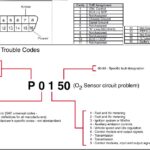Having trouble connecting your OBD2 scanner to your 2000 Volkswagen Golf? It’s a frustrating situation, especially when you’re trying to diagnose a check engine light or other potential issues. A non-functional OBD2 port means you can’t access crucial diagnostic information from your car’s computer, hindering your ability to troubleshoot problems effectively. Let’s explore the common reasons why the OBD2 port on your 2000 Golf might not be working and guide you through some troubleshooting steps.
Potential Reasons Why Your 2000 Golf OBD2 Port Isn’t Working
Several factors can contribute to a malfunctioning OBD2 port. Before assuming a major electrical problem, consider these common culprits:
Blown Fuse
The most frequent cause of a dead OBD2 port is a blown fuse. The OBD2 port shares a fuse with other vehicle systems, and a surge or short circuit can easily blow this fuse, cutting power to the port. This is the simplest and often the easiest issue to resolve.
Faulty OBD2 Port
While less common than a fuse issue, the OBD2 port itself can sometimes fail. Physical damage, corrosion, or loose pins within the port can prevent a proper connection with your scan tool. Over time and repeated use, the port can simply wear out.
Wiring Problems
The OBD2 port relies on a network of wires to connect it to your car’s computer (ECU/PCM). Damage to these wires, such as cuts, breaks, or corrosion, can interrupt the communication and render the port unusable. This could be due to rodent damage, wear and tear, or previous repairs.
Scanner Compatibility Issues
Although OBD2 is a standardized system, some older or very basic scan tools might have compatibility issues with certain vehicles. While less likely with a 2000 Golf, it’s worth considering if you are using an older or very inexpensive scanner.
ECM/ECU Problems (Less Likely)
In rare cases, a problem with the car’s Engine Control Module (ECM) or Powertrain Control Module (PCM) itself could be the root cause. The ECM/PCM is the computer that the OBD2 port communicates with, and if it’s malfunctioning, the port might not work correctly. However, ECM/PCM failures are usually accompanied by other more noticeable vehicle problems.
Troubleshooting Your 2000 Golf OBD2 Port
Here’s a step-by-step approach to diagnosing and potentially fixing your 2000 Golf’s OBD2 port:
Step 1: Check the Fuses
This should always be your first step due to its simplicity.
- Locate your fuse box: Typically, fuse boxes are found inside the car (often under the dashboard or to the side) and sometimes in the engine compartment. Refer to your 2000 Golf owner’s manual for the exact location.
- Identify the OBD2 fuse: Your owner’s manual’s fuse diagram will label the fuse related to the OBD2 port or diagnostic system. It might also be labeled as “accessory power” or “cigarette lighter” fuse, as these systems sometimes share the same circuit.
- Inspect the fuse: Visually check the fuse. A blown fuse will usually have a broken wire inside or look burnt.
- Replace the fuse: If the fuse is blown, replace it with a new fuse of the exact same amperage. Do not use a higher amperage fuse, as this can cause further damage.
- Test the OBD2 port: Try connecting your scan tool again to see if the port is now working.
Image alt text: OBD2 port location under the dashboard of a vehicle, commonly found near the steering column for easy access during car diagnostics.
Step 2: Inspect the OBD2 Port
Carefully examine the OBD2 port itself for any signs of damage:
- Visual inspection: Look for any physical damage to the port, such as cracks, broken plastic, or bent pins.
- Check for corrosion: Inspect the pins inside the port for any signs of corrosion or rust.
- Pin tightness: Gently wiggle each pin to see if any are loose or pushed in. Loose pins can prevent proper contact.
- Clean the port: If you see corrosion or debris, use a contact cleaner spray (specifically designed for electronics) to gently clean the port.
Step 3: Try a Different OBD2 Scanner
If you have access to another OBD2 scanner, try using it to connect to your 2000 Golf. This will help rule out a problem with your original scan tool. If the second scanner works, then the issue is likely with your original scanner and not your car’s OBD2 port.
Step 4: Inspect Wiring (Visual Check)
A more in-depth wiring inspection might require professional help, but you can start with a visual check:
- Trace the wires: Locate the wires connected to the back of the OBD2 port (you may need to carefully access the back of the port).
- Look for damage: Follow the wires as far as you can, looking for any obvious signs of damage like cuts, breaks, or frayed insulation.
- Check connectors: Examine any connectors along the wiring path for looseness or corrosion.
Step 5: Seek Professional Help
If you’ve checked the fuses, inspected the port, tried a different scanner, and visually inspected the wiring, and the OBD2 port is still not working, it’s time to seek professional help. A qualified mechanic or auto electrician can:
- Perform a more thorough wiring diagnosis using specialized tools.
- Test the OBD2 port and related circuits for power and continuity.
- Diagnose potential ECM/PCM issues.
Image alt text: Automotive technician connecting a professional OBD2 scan tool to a car’s diagnostic port to read fault codes and diagnose engine problems.
Conclusion
A non-working OBD2 port on your 2000 Golf can be a significant obstacle to diagnosing car problems. By systematically troubleshooting, starting with the easy fixes like fuses and port inspection, you can often identify and resolve the issue yourself. However, don’t hesitate to consult a professional if you’re uncomfortable with electrical diagnostics or if the problem persists after your initial checks. Getting your OBD2 port functioning again will empower you to understand your car’s health and address any underlying issues effectively.
